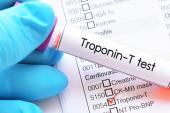Differentiating Type 1 and Type 2 MI Still ‘Both Art and Science’
Vetting a host of novel CV biomarkers didn’t turn up any that provide much additional help in discriminating between the two.

The hunt continues for a simple lab test that might help clinicians expeditiously sort out which type of MI is afflicting patients who present to the emergency department with chest pain, so as to streamline care. The latest effort, which evaluated 17 novel CV biomarkers, failed to uncover any that offered much in the way of help.
None was significantly better at discriminating between type 1 and type 2 MI when compared with troponins measured using high-sensitivity assays, which themselves have only modest diagnostic value for this purpose, Thomas Nestelberger, MD (Vancouver General Hospital, Canada, and University Hospital Basel, Switzerland), and colleagues report in a study published online April 21, 2021, ahead of print in JAMA Cardiology.
“Altogether, there was just moderate discrimination [for the] performance of all the novel biomarkers,” Nestelberger told TCTMD. “Further studies are needed to find better ways to discriminate between type 1 and type 2 MI.”
The distinction is important, he stressed, because treatments differ substantially. Patients with type 1 MI typically require aggressive antithrombotic therapy and urgent revascularization to clear a blocked coronary artery, whereas those with type 2 MI need to have the underlying trigger of the oxygen supply-demand mismatch treated.
Commenting on the results, Marc Sabatine, MD (Brigham and Women’s Hospital, Boston, MA), the deputy editor of JAMA Cardiology who wrote an accompanying editor’s note, told TCTMD, “Unfortunately, I think we’re left with the fact that it’s an important clinical question illustrating that medicine is both art and science. We have the patient’s history, which can give us important clues. We have a biomarker, troponin, that can give us some sense. But we need to just integrate them, and unfortunately there’s no one perfect test that will discriminate between type 1 and type 2 MI.”
Currently, physicians in the emergency department tackle the difficult problem by considering a combination of factors to determine which type of MI a patient has, including clinical history, symptoms, and troponin concentration, Nestelberger said. But even though troponin levels are higher in the setting of type 1 MI, there is still substantial overlap in the ranges between type 1 and type 2 MI, he added, so a test that can provide better discrimination is desirable.
Keeping APACE With Chest Pain
For this study, the investigators turned to the ongoing Advantageous Predictors of Acute Coronary Syndromes Evaluation (APACE) study, conducted at 12 emergency departments in five European countries. The current analysis included 5,887 patients (median age 61 years; 32.6% women) who presented with acute chest discomfort; 18.8% received an adjudicated final diagnosis of MI. Most (77.8%) had type 1 MI, and the rest had type 2, as defined by the Fourth Universal Definition of MI.
Unfortunately, there’s no one perfect test that will discriminate between type 1 and type 2 MI. Marc Sabatine
All patients underwent a clinical evaluation that included medical history, vital signs, a physical exam, 12-lead ECG, continuous ECG rhythm monitoring, pulse oximetry, standard blood tests, and chest radiography if indicated. In addition to high-sensitivity cardiac troponin I and T, 17 novel CV biomarkers indicative of cardiomyocyte injury, endothelial dysfunction, hemodynamic cardiac stress, endogenous stress, plaque instability and angiogenesis, inflammation, or a combination of inflammation, hemodynamic stress, and vascular aging were measured.
Type 2 MI was associated with lower concentrations of biomarkers related to cardiomyocyte damage at presentation, including high-sensitivity troponin T (median 30 vs 58 ng/L), high-sensitivity troponin I (median 23 vs 115 ng/L), and cardiac myosin-binding protein C (median 76 vs 257 ng/L; P < 0.001 for all).
On the other hand, type 2 MI was associated with higher levels of four biomarkers of endothelial dysfunction, microvascular dysfunction, and/or hemodynamic stress (P < 0.001 for all):
- C-terminal proendothelin 1 (median 97 vs 68 pmol/L)
- Midregional proadrenomedullin (0.97 vs 0.72 pmol/L)
- Midregional pro-A-type natriuretic peptide (MR-proANP; 378 vs 152 pmol/L)
- Growth differentiation factor 15 (2.26 vs 1.56 ng/L)
However, discrimination between type 1 and type 2 MI for all of these biomarkers, according to the area under the receiver operating characteristics curve, was only modest and was not significantly different compared with the troponins.
The highest AUC value was seen for MR-proANP (0.77), a biomarker of hemodynamic stress, and a multivariable analysis “suggested a possible additive value of MR-proANP to clinical variables,” the researchers report. Nestelberger said it’s worth looking into this particular biomarker further.
Beating Troponin
Because troponin is already routinely used, it’s hard to imagine clinical adoption of any of the other biomarkers evaluated in this study, Sabatine said.
Asked why it’s so hard to find a straightforward test that can distinguish type 2 MI from type 1 MI, he cited the difficulty of determining what’s happening inside the coronary arteries by only using a circulating biomarker.
“We don’t have anything specific enough for plaque rupture that we can detect in the bloodstream that actually speaks of the plaque rupture itself versus the consequences of that,” he said.
Nestelberger pointed out that it has been a challenge, too, because the definition of type 2 MI has varied across studies, making it difficult to compare results. He underscored the importance of adhering to the classifications in the Fourth Universal Definition of MI and not including certain groups of chest patients under the type 2 MI umbrella, such as those with acute heart failure, myocarditis, or pulmonary embolism.
Ultimately, the way type 2 MI will be distinguished from type 1 MI in the future—even if better biomarkers are identified—will involve a combination of clinical assessment, medical history, and lab tests, as well as noninvasive imaging to determine whether there is underlying coronary disease that needs to be treated, Nestelberger said.
Todd Neale is the Associate News Editor for TCTMD and a Senior Medical Journalist. He got his start in journalism at …
Read Full BioSources
Nestelberger T, Boeddinghaus J, Lopez-Ayala P, et al. Cardiovascular biomarkers in the early discrimination of type 2 myocardial infarction. JAMA Cardiol. 2021;Epub ahead of print.
Sabatine MS. Differentiating type 1 and type 2 myocardial infarction: unfortunately, still more art than science.
Disclosures
- The study was supported by research grants from the Swiss National Science Foundation, the Swiss Heart Foundation, University of Basel, University Hospital of Basel, the Stiftung für Kardiovaskuläre Forschung Basel, Abbott, Beckman Coulter, Biomerieux, Brahms, Roche, Siemens, and Singulex. All investigated assays were donated by the manufacturers (8sens.biognostic GmbH, Abbott Laboratories, Roche Diagnostics, Nunc, Athera Biotechnologies, Millipore Sigma, and Brahms AG).
- Nestelberger reports having received research support from the Swiss National Science Foundation, the Professor Dr Max Cloëtta Foundation, the Margarete und Walter Lichtenstein-Stiftung, University of Basel, and the University Hospital Basel, as well as speaker/consulting honoraria from Siemens, Beckman Coulter, Bayer, Ortho Clinical Diagnostics, and Orion Pharma outside the submitted work.
- Sabatine reports grants from Anthos Therapeutics, AstraZeneca, Bayer, Daiichi Sankyo, Eisai, Intarcia Therapeutics, The Medicines Company, MedImmune, Merck, Novartis, Pfizer, and Quark Pharmaceuticals; and personal fees from Althera, Amgen, Anthos Therapeutics, AstraZeneca, Bristol-Myers Squibb, CVS Caremark, DalCor Pharmaceuticals, Dr. Reddy’s Laboratories, Dyrnamix, IFM Therapeutics, Intarcia Therapeutics, The Medicines Company, MedImmune, and Merck. He is a member of the TIMI Study Group, which has also received institutional research grant support from Brigham and Women’s Hospital from Abbott Laboratories, Regeneron, Roche, and Zora Biosciences.




Comments